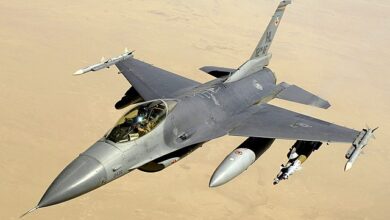
- The fighter uses the PL-15 long-range air-to-air missile, which easily outperforms the Su-30's Russian R-77 and French MICA.
- Both fighters use Mach 3 capable missiles for standoff air-to-ground and anti-shipping missions, the YJ-93 for the J-10C based on the Russian Kh-31 and the BrahMos for the Su-30MKI.
Confirmation that Pakistan has become the first client for the Chinese J-10C ‘4++ generation’ single engine fighter has raised numerous concerns about the Pakistani Air Force’s future and the regional balance of power. Pakistan’s Interior Minister, Sheikh Rasheed, confirmed the acquisition in late December, stating that the Air Force would field a full J-10C squadron in time for the country’s March 23rd Parade.
The fighter will undoubtedly be the most capable in Pakistani service, complementing the lighter and less expensive JF-17 Block III, which first flew in 2019 and has comparable avionics and armaments but inferior flight performance. The extent to which the J-10C will be able to challenge the primacy of the region’s most capable fighters, the Indian Air Force’s fleet of Su-30MKI ‘4+ generation’ heavyweight fighters, remains unknown.
The Indian Air Force has been using Su-30s since the late 1990s, and in 2002 began deploying the advanced MKI variant, which now forms the backbone of the country’s combat fleet. Over 270 are currently in service, with more expected to be delivered in 2022.Should the Indian Air Force engage in air-to-air combat with the J-10C, the Su-30MKI is the most likely fighter to do so due to its widespread use and elite status.
As a heavyweight fighter, the Su-30MKI has several significant advantages over the J-10C. The aircraft’s endurance is significantly increased, which means it can carry significantly more ordinance over significantly longer distances, which is useful for offensive operations or long-range patrols.
Its second seat accommodates a weapons systems officer, which is especially useful when performing extreme manoeuvres or engaging both ground and aerial targets at the same time.Indeed, the primary feature that Chinese fighter pilots claimed gave the J-16 heavyweight fighter an advantage over the J-10C in mock engagements was twin seats. Because of its higher speed and altitude, the Su-30 can launch missiles with significantly more energy than rival fighters.
This includes not only the J-10C, but also the Rafale lightweight fighters acquired from France recently, which are even slower and lower flying than the J-10.While the J-10 is a lighter design, it has a number of significant advantages. The aircraft, which will enter service 16 years after the Su-30MKI, benefits from China’s much larger technological base and scale of research and development, and boasts superiority in avionics, particularly in its sensors and electronics.
The J-10C employs an AESA radar, which, while smaller than the Su-30MKI’s Bars PESA radar, is significantly more difficult to jam, more efficient, and opens up more possibilities for electronic warfare. The fighter uses the PL-15 long-range air-to-air missile, which easily outperforms the Su-30’s Russian R-77 and French MICA.
This is true not only for range, where it is estimated to be twice as long (250-300km vs. 110km for R-77 and 80km for MICA), but also for sensors, as it is the only operational air-to-air missile outside of Japan to use an AESA radar for guidance. This not only makes the PL-15 less susceptible to jamming, but also significantly more reliable and capable of forming locks against stealth targets. Both fighters use Mach 3 capable missiles for standoff air-to-ground and anti-shipping missions, the YJ-93 for the J-10C based on the Russian Kh-31 and the BrahMos for the Su-30MKI.
The BrahMos is a much heavier but more capable missile that takes advantage of the Su-30’s long endurance. Unlike the J-10C, which can rearm with the YJ-93 at the base, Su-30MKI units require modifications to use the BrahMos with special units assigned to carry the missiles, limiting the Su-30’s versatility.For shorter-range air-to-air combat, the J-10C’s PL-10 missile with high off-boresight targeting capabilities is expected to provide an advantage, albeit a less overwhelming one, over Indian fighters.
The J-10C is possibly the only non-Russian fighter in the world that can match the Su-30MKI’s manoeuvrability, as both use thrust vectoring engines, though the lighter Chinese jet has a higher thrust/weight ratio due to its airframe’s extensive use of light composite materials. The J-10 has the world’s highest altitude ceiling for an operational single engine fighter, though it is still slightly lower than the Su-30MKI.
Aside from significantly lower operational and maintenance costs, the J-10C’s primary advantage over the Su-30MKI is its superior electronics and data links, which allow units to better and more reliably network with other assets such as drones and air defence systems to combat an adversary.
This is thought to be the primary factor that enabled J-10Cs to reportedly outperform Russian-built Su-35 heavyweight fighters in 2020 mock air battles.The J-10C in Pakistani hands will pose a challenge to the Indian Air Force like no other since the Cold War, with Indian superiority long guaranteed by the Su-30MKI and, prior to that, by MiG-29s armed with R-27 missiles.
Despite this, the Su-30MKI is relatively old in comparison to more modern Russian fighter designs, and if modernised with next generation technologies, it has the potential to bridge existing performance gaps, if not comfortably surpass the J-10C. R-37M missiles with 400km engagement ranges, Iribis-E PESA radars or derivatives of the N036 AESA radar, AL-41 engines, and new avionics and electronic warfare systems are among them.
While the Su-30MKI is a higher-end fighter in the same weight range as the Chinese J-16, and was widely regarded as the most capable fighter in the world by a wide margin when it entered service in 2002, many of its technologies are now outdated, allowing lighter but more sophisticated aircraft such as the J-10C to challenge its formerly unrivalled superiority in the region.
Nonetheless, Pakistan’s J-10C acquisitions are not expected to reach even a fraction of India’s current Su-30MKI fleet size, with only a single squadron currently confirmed, implying that the Indian Air Force will retain an overwhelming numerical advantage despite the fact that its top fighters are much heavier and more expensive.







Facebook Comments